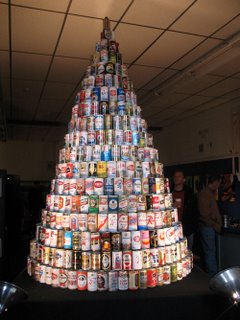Alternative Space: Harvey Riggs; Rob Narracci; David Coon
City-Wide Open Studios
50 Orange St., New Haven, (203) 772-2709
Alternative Space: Harvey Riggs; Rob Narracci; David Coon
Oct. 28-29, 2006.
When a friend of Harvee Riggs dubbed him the "last stop before the dumpster," Riggs took it as a compliment. Like many artists who create box assemblages, Riggs finds beauty and new meaning in materials most folks might consider worn out junk. Besides counting on the kindness of (spring-cleaning) friends, Riggs haunts flea markets and tag sales looking for potential assemblage components.
One year, Riggs and his wife explored the "largest tag sale in the United States." It encompasses a stretch starting just south of Cincinnati, runs through Kentucky into Tennessee, down into Alabama and cuts over to Georgia.
"It seems like every 20 feet there's someone with a tag sale," Riggs told me. Did he have much success finding useful objects? "Unfortunately, no. I found a half dozen objects, which makes them pretty expensive when you factor in rooms, gas and meals. But it was fun."
Riggs had been a painter. He started making assemblages about five years ago. His initial impetus was to use them as dioramas from which to compose surrealist paintings. But they so intrigued him that he didn't go back to painting.
The works aren't planned, Riggs said. He starts by choosing a central object—for example, the guitar in "Noodling the Groove"—and then adding pieces to see where they might fit. In that case, he combined two cranberry bog boxes to make the case. Parts of an old mechanical pinball machine—particularly the play field with its imagery of a swing band—were used for "With Musical Accompaniment". Riggs built his own box and incorporated tambourine discs as a design element. The works need to be permanent so the disparate objects are adhered and fastened with screws, nails, wire and glue. He has a collection of rusty screws and nails handy.
"I like to use objects that have character and been around to show it. Shiny things are just glitter," Riggs said. "Rusted? Broken? Doesn't matter. Scratched? All the better."
And if the components he wants to use don't display the toll of time and wear, Riggs is willing to work them over until they do. "Schoolhouse Chair" is built with a child's chair and a pair of mannequin arms.
"They were brand new when I bought them. But that doesn't work with my sensibility," said Riggs. So he scuffed them and stained them until they could pass as antiques. The work is a comment on lost innocence and possibility. The child within the seat has ideas about the world, dreams. But the adult, represented by the mannequin arms is shackled to the world of work and limitations. Like the rest of Riggs' displayed works, it was marked by a powerful sense of composition and balance.
•••
"I try to bring some order to the savage disarray," said Rob Narracci. An architect by day, Narracci was showing his more austere assemblages and hanging maquettes in a different room and building but his affection for worn objects echoed that of Riggs.
"To me, there's something really primal and beautiful about an old object that has the shadow of a process on it," he said. He used old type trays stained with ink and lead, and torn up flooring recovered from a dumpster at Yale in his art.
"I have a hard time parting with shit, which is horrible because I paid for it," said Narracci. "I just moved and have maps I pulled out of a dumpster at Penn State in the late 1980's." For his hanging sculptures, Narracci cut some of the maps into long ribbons. He had noticed a crisscrossing of shadows as he assembled the sculptures and took it further by binding them with the maps. Curious, he wrapped the ribbon around and around to see if it might meet up with itself, as in a Moebius strip. And it did.
He had slaved over the discarded floorboards, pulling out the old square cut nails. Some came out bent; others pulled out straight. They were discolored to varying degrees by mill scale, the coating of dirt and rust that often forms on the surface of forged or hot worked iron or steel. Narracci was intrigued by the colors of blue and ochre in the nails.
"I can't paint and I'm always jealous of people who can," he told me. So he used the dark colorful nails as a paint medium and old type trays as canvases.
•••
And then, for those drunk with an effervescent affection for ales past, there was David Coon's "Beeramid." Five hundred cans, collected by Coon in the 1980's, stacked around a rigid foamcore interior. Each of them different, most of them obscure.

"If you really want to get into it, it is about the death of regional brands. The death of quality graphic design," Coon said. They were collected pre-eBay, and designed pre-computers. Most of the brands were indigenous to the Baltimore and Pennsylvania area; Coon grew up in suburban Washington, D.C. Coon claimed, with no evidence to back him up, that "this is the only beeramid that has a multimedia component." A video of Internet-derived images of other peoples' beeramids played in a nearby corner.
"It celebrates a time period that's gone, unfortunately forever," said Coon, nursing a Schaefer.

0 Comments:
Post a Comment
<< Home